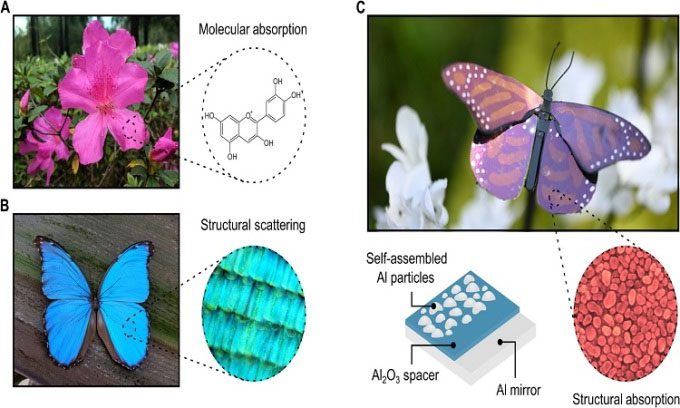Inspired by butterflies, a research team at the University of Central Florida (UCF) has developed an environmentally friendly paint that helps save energy and reduce global warming.

The research team creates energy-saving paint inspired by butterflies. (Photo: Science Advances)
Researcher Debashis Chanda, a professor at UCF’s Nano Science Technology Center, and his colleagues described the development process of this new paint on March 8 in the journal Science Advances. Based on biological inspiration, Chanda’s research team invented plasmon paint, which uses a nanostructured arrangement of colorless materials like aluminum and aluminum oxide instead of pigments. While traditional dye pigments control light absorption based on the electronic properties of colored materials—which means each color requires a new molecule—structural dyes control how light is reflected, scattered, or absorbed based on the geometric arrangement of the nanostructures.
Structural dyes are environmentally friendly because they only use metals and oxides, unlike current pigments that rely on synthetic molecules. The researchers combined structural dyes with commercial binders to create a durable paint in all colors. “Conventional colors fade because the dyes lose their ability to absorb photons,” Chanda said. “Here, we are not limited by that phenomenon. When painting an object with structural dyes, the paint layer will last for centuries.”
Furthermore, because plasmon paint reflects the entire infrared spectrum, it absorbs less heat. As a result, the surface beneath it remains cooler by 13.8 to 16.6 degrees Celsius compared to standard commercial paints. “Over 10% of the total electricity in the U.S. is used for air conditioning,” Chanda noted. “The temperature difference that plasmon paint promises to deliver will help significantly save energy while also reducing carbon dioxide emissions, contributing to the fight against global warming.”
Plasmon paint is also extremely lightweight due to its high area-to-thickness ratio. The thickness of the paint layer is only 150 nanometers, making it the lightest paint in the world. This paint is so light that only 1.4 kg of plasmon paint is sufficient to coat a Boeing 747, which would normally require over 454 kg of conventional paint. According to Chanda, the next step of the project includes further exploring the energy-saving characteristics of the paint to improve its commercial production viability.


















































